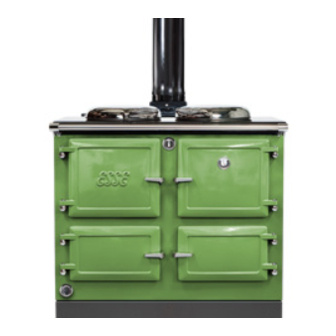
Esse 990 CH Operating Instructions Manual
Hide thumbs
Also See for 990 CH:
- Installation & commissioning instructions (4 pages) ,
- Installation & commissioning instructions (12 pages) ,
- User hints & tricks (6 pages)
Table of Contents
Advertisement
Quick Links
Advertisement
Table of Contents

Subscribe to Our Youtube Channel
Summary of Contents for Esse 990 CH
- Page 1 OPERATING INSTRUCTIONS MODEL: 990 CH...
-
Page 2: Table Of Contents
Ensure that precautions are taken when deep fat frying, never leave the appliance unattended and ensure you have fire safety equipment available such as a fire blanket in case of emergency. When operating the ESSE 990 CH use the tools provided and follow these instructions carefully. -
Page 3: Before Using Your Cooker
BEFORE USING YOUR COOKER CHIMNEY AND FLUE INFORMATION YOUR COOKER CHIMNEY AND FLUE INFORMATION Ensure that any plastic film used to protect surfaces has been removed from the bolster lids and from the inside of oven doors. The hotplate has been coated with oil at the factory to prevent rusting and therefore will require wiping with a damp cloth and drying with a tea towel or kitchen roll. -
Page 4: Lighting And Controlling The Cooker
LIGHTING AND CONTROLLING THE COOKER Open flue damper by moving the lever away from you. Open the fire door and using either rolled up paper or a firelighter on top of which small sticks of dry kindling wood has been placed, light the fire. Depending on how well the chimney is pulling, close or partially close the door until the kindling is well alight. -
Page 5: Cooking In The Ovens
Choice of fuel Should you burn smokeless fuel or wood? If you are located in a smoke control zone, then you have to burn an approved smokeless fuel. The boiler output will be higher with solid fuel than wood. Solid fuel is a more concentrated energy source, therefore it is possible to load the firebox with more potential energy in the form of solid fuel than wood. -
Page 6: Types Of Fuel
TYPES OF FUEL SEASONING AND STORING FIREWOOD Wood, which has recently been cut and is still full of sap and water is known as "green" wood. Greenwood will generally burn poorly and inefficiently, because it can have over 50% water in its cells. It may be hard to light, smoulder, not put out any heat and cause more than the usual amount of creosote to build up in your chimney. -
Page 7: Operating Tips
The resulting residue that sticks to the inner walls of the chimney is called creosote. Creosote is formed by unburned, flammable particulates present in the smoke. It is black or brown in appearance. It can be crusty and flaky, tar-like, drippy and sticky or shiny and hardened. Quite often, all forms will occur in one chimney system. -
Page 8: The Importance Of A Healthy Flue
Cooker B was just 6 weeks old when the picture was taken and shows how quickly tar deposits will build up if the flue performance is poor and clogged with old soot as it was in this case. (N.B. Cooker shown for illustration is not a 990 CH) Fig.3... -
Page 9: Cleaning The Flue Ways
Cooker A Cooker B Good draft & clean flue = efficient wood burning, Poor draft & dirty flue = inefficient wood burning, clear flue ways, minimal soot and no tar deposits. blocked flue ways, lots of soot and tar deposits. CLEANING THE FLUE WAYS - Every 3 months Always carry out cleaning procedures when the cooker is out and has been allowed to cool sufficiently to avoid burns. - Page 10 Fig.6 Fig.8 Lightly brush surfaces with Fig.7 a wire brush and vacuum up debris. Lift hotplate with care and place on newspaper or an old sheet. FLUE BOX AND REAR FLUE WAY Remove the front of the flue connector box and insert the flue brush from left to right, angling the brush down at 45°.
-
Page 11: Cleaning The Exit Flue
CLEANING THE FLUE WAY BETWEEN THE OVENS Remove the inspection cover in the base of the main oven and insert the flue rake, raking from side to side and making sure the rake reaches the back and the side of the flueboxes. Vacuum the soot. Fig.10 Fig.11 Open top oven door, insert tool and... - Page 12 • The cooker is serviced annually by the ESSE Such damage will not be covered by your Dealer or authorised HETAS engineer, and the warranty.



Need help?
Do you have a question about the 990 CH and is the answer not in the manual?
Questions and answers